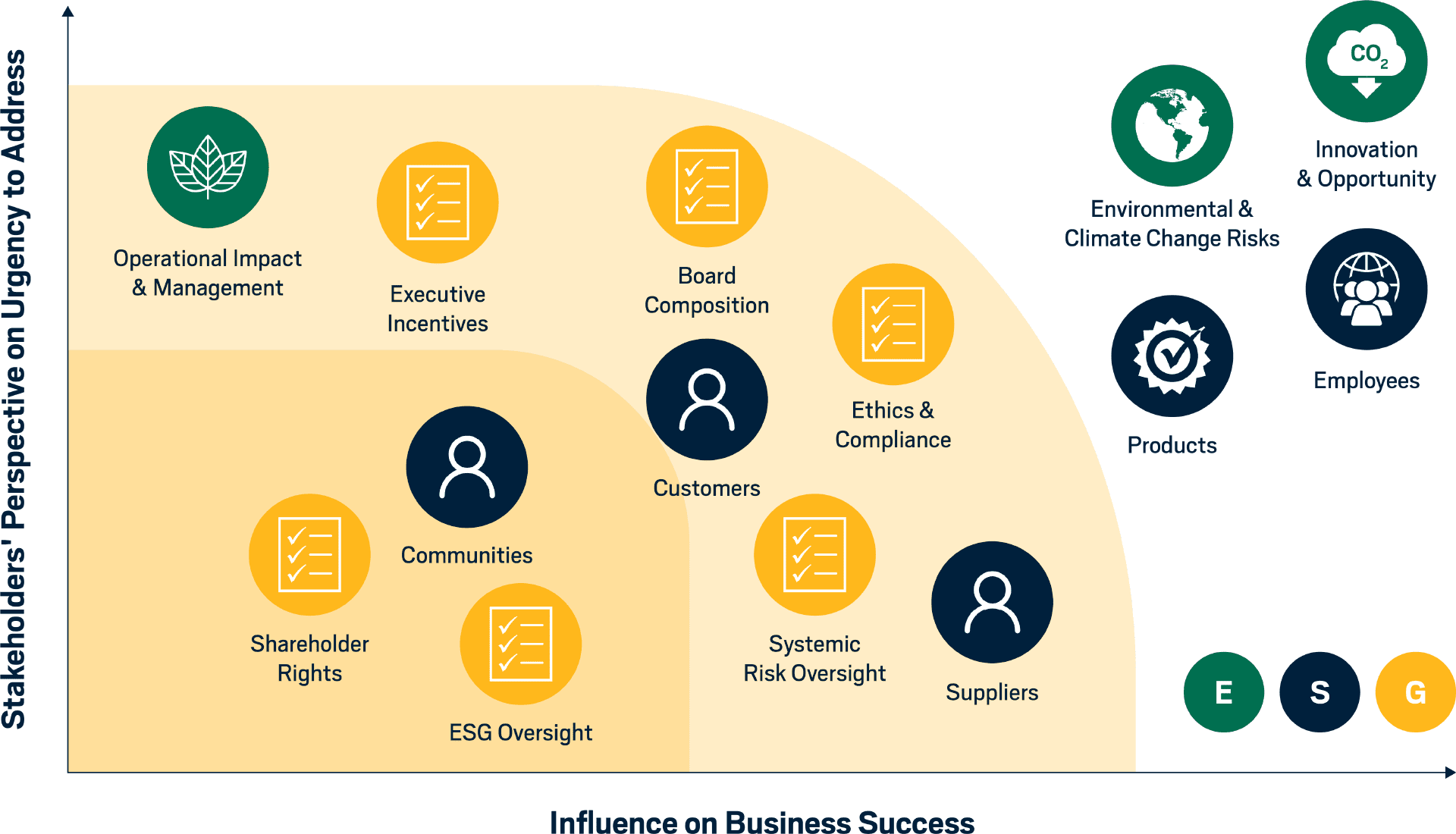
Engineering Innovative and Forward-Thinking Solutions
Sustainability Priorities
Our sustainability objectives are driven by our business strategy and stakeholder feedback, a key element of our materiality assessment process. Our first materiality assessment, completed in 2020, involved four stages: peer identification and benchmarking, material area and topic identification, stakeholder engagement, and analysis and finalization of material topics. We rigorously selected our peer group for benchmarking purposes, reviewing peer materiality assessment outputs and key topics of relevance from the Sustainability Accounting Standards Board (SASB), Global Reporting Initiative (GRI), and Task Force on Climate-related Financial Disclosures (TCFD).
We engaged a wide segment of our stakeholders including internal leaders, investors, our Board of Directors, and a diverse cross section of our employees to survey, which determined 14 key topics on which to focus our strategy. Four of those topics were deemed the most material to delivering long-term value to our stakeholders and became the focus of our first set of corporate sustainability goals.
In 2023, we once again surveyed and interviewed our stakeholders to ensure our sustainability strategy remains aligned with the evolution of our business. The results of this assessment process and any associated adjustments to our sustainability priorities, goals, and roadmap will be published by the end of 2024.
- Innovation & Opportunity
- Environmental & Climate Change Risks
- Employees
- Products
Each goal has associated targets and key performance indicators (KPIs) that we use to measure our progress. Several of our targets are ongoing and will require our continued attention to ensure that we remain on track year after year. Others have specific deadlines and deliverables; as we achieve those goals, we look for opportunities to create new goals and KPIs in their place so that our strategy continues to evolve. In accordance with our strategic roadmap, we announced our first corporate emissions reduction target in 2023 and have committed to reducing our greenhouse gas emissions as outlined in the goal progress section below.

Material Topics Definitions
Environmental
Physical risks, such as rising sea levels, climate impacts of our business mix, critical material and transition risks related to regulation, technology, and reputation.
Developing diversified solutions across industries to favorably impact energy consumption in addition to associated cost savings for end users.
The operational impact and management of GHG and toxic emissions, waste, biodiversity, and land use, and natural resources such as water.
Social
Energy Recovery’s engagement and impact on the local communities where we operate including topics such as volunteering, investment and contributions with local impact, disaster response, and supporting community rights.
The social impact of Energy Recovery’s products and our customer relationship management and communication channels.
Energy Recovery’s management of our employees, focusing on health and safety, well-being, professional development and talent attraction, diversity and inclusion, compensation, and open feedback channels.
Our product safety, reliability, quality control, and brand perception.
Management of supplier labor conditions and workforce safety, human rights, and proper sourcing practices.
Governance
Board structure, diversity, independence, size, expertise, and refreshment.
Stakeholder engagement, ongoing ESG education, and oversight of ESG reporting, sustainability performance, and strategy-setting.
The company’s processes, policies, and oversight structures in place to ensure management of bribery and corruption, conflicts of interest, marketing, tax transparency, and adherence to all applicable regulations.
Energy Recovery’s executive to median pay, long-term incentive ties, long-term incentive vesting structure, and performance incentives tied to ESG metrics.
Energy Recovery’s practices regarding shareholder rights and engagement including proxy access, voting rights, right to appoint directors, right to call a special meeting, and the right to act by written consent.
Energy Recovery’s formal risk oversight structures and policies related to risks such as cybersecurity succession planning, intellectual property, and climate change.
Goal Progress
Our goal progress dashboard offers a high-level overview of our progress on our goals and targets.
Achieved and Ongoing
On Track
Environmental Goals
Double emissions reductions from Energy Recovery products by end of 2025 vs. 2019 baseline
Reduce Scope 1 and 2 GHG emissions intensity 65% by 2026 from 2021 baseline
Report climate-related risk strategy and management aligned with TCFD by end of 2024
Social Goals
Develop workforce to deliver sustainable, diversified growth
Maintain retention rate above 90%
100% of new hires receive sustainability training within 3 months
Maintain new hire turnover rate below 10%
Maintain Great Place to Work survey participation rate above 70%
Protect our employees by providing a safe and healthy working environment
Aim towards total recordable incident rate of zero
Achieve 95% of planned annual safety trainings
Deliver products and solutions customers can trust
Maintain warranty expense below 1% of total product revenue
Maintain zero monetary losses associated with legal proceedings due to product health and safety incidents